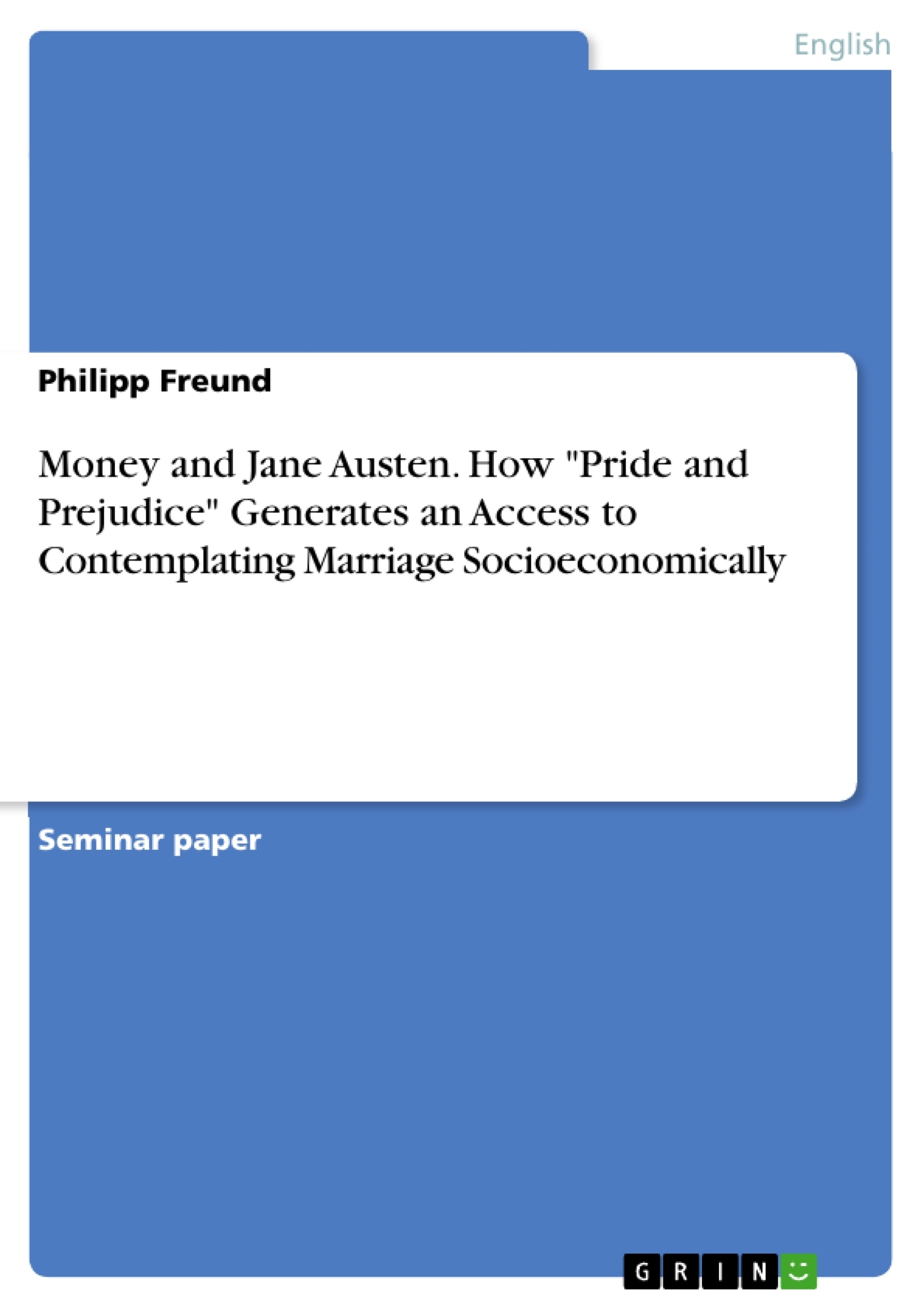“There is a tendency to think of the settings of Austen’s novels as if they resemble Downton Abbey a hundred years earlier”. With this quote, Davidson introduces the broad topic of the paper: inheritance, money, love, society – and what goes along with it. Whether it is Downton Abbey or Jane Austen’s Pride and Prejudice, the “financial status and the operations of inheritance play a fundamental role”, which is “never speaking openly, but always present”. But, to intervene right at the beginning of this funny looking idea of a paper about English literature, one could state the question of money and Jane Austen – How Pride and Prejudice generates an access to contemplating marriage socioeconomically as absolutely vital, as “economic interpretations of literature often reveal the power base of the society on which the novel is built as well as the author’s own view about the appropriateness of that power base”.
In other words, and to define the very problem of the novel: “Mr. Bennet […] is unable to use his property to provide for his family after his death since one of the stipulations included in most legal entailments was that, if there were no son to inherit the property, it would descend to the eldest nephew or male cousin in the next generation of the family”, which leads Büttner to summarize the entire novel and say that it is basically all about sex and money. The paper, hence, should analyse this problem in form of a vivisection of social restraints, in which possession seems to control love and in order to investigate about Austen’s ability to discriminate against social habits and practices of her time.
This is, to legitimize the choice of the text, exactly the point, why one should have a close look at Jane Austen. She is not just a very famous female writer in English literature, but one of the most knowns for criticising society and structures. The specific topic however, is derived from the heart of analyses, contemplating the details of characters, plots, settings, and so on, while rather few scholars seem to concentrate on the meaning a novel can convey for understanding the time and circumstances it comes from. Most of them focus on the author and want to compare the author’s real life with the novel. This is, in kind, not of big use, because one simply can answer the question if the novel was written according to the author’s life.
Inhaltsverzeichnis (Table of Contents)
- Introduction
- Common View on Money and Marriage during the 18th and 19th Century
- Theoretical Background
- Max Weber’s Klassenbegriff
- Max Weber’s Herrschaftssoziologie
- Money in Pride and Prejudice – Key Moments of Money and Marriage
- Moment 1: Mr. Bennet and his Situation
- Moment 2: Elizabeth’s Resistance
- Moment 3: Outcome – Rules of Society
- Understanding the Historical Context because of the Novel
- Criticism in Jane Austen’s Pride and Prejudice
Zielsetzung und Themenschwerpunkte (Objectives and Key Themes)
This study aims to explore the interplay between money and marriage in Jane Austen’s Pride and Prejudice, using Max Weber’s theories of class and Herrschaftssoziologie as a framework. By examining key moments in the novel, it seeks to highlight how the characters’ social positions, economic circumstances, and marriage aspirations intersect to shape their experiences and relationships.
- The role of money and social class in shaping individual choices and relationships
- The societal pressures and expectations surrounding marriage and financial security
- The influence of Max Weber’s theories on understanding the social dynamics of Pride and Prejudice
- The interplay of class, gender, and power within the novel’s narrative
- The enduring relevance of these themes for contemporary readers
Zusammenfassung der Kapitel (Chapter Summaries)
The introductory chapter provides an overview of the common perceptions regarding money and marriage during the 18th and 19th centuries, setting the stage for the subsequent analysis of Pride and Prejudice.
Chapter 2 delves into the theoretical foundation of the study, drawing on Max Weber’s concepts of class and Herrschaftssoziologie. It examines the significance of Weber’s theories for understanding the social dynamics portrayed in Pride and Prejudice, particularly in relation to the characters’ social positions and power structures.
Chapter 3 focuses on key moments in Pride and Prejudice that illuminate the interplay of money and marriage. It explores how economic circumstances and social expectations influence the characters’ decisions and relationships, particularly those of Mr. Bennet, Elizabeth, and Mr. Darcy.
Chapter 4 further examines the historical context of Pride and Prejudice, highlighting how the novel critiques the prevailing social norms and expectations surrounding marriage and financial security. It also discusses the enduring relevance of these themes for contemporary readers.
Schlüsselwörter (Keywords)
The key keywords and focus topics of the text include: Jane Austen, Pride and Prejudice, money, marriage, class, Herrschaftssoziologie, Max Weber, social dynamics, societal expectations, historical context, gender, power, and contemporary relevance.
- Citar trabajo
- B.A. Philipp Freund (Autor), 2018, Money and Jane Austen. How "Pride and Prejudice" Generates an Access to Contemplating Marriage Socioeconomically, Múnich, GRIN Verlag, https://www.grin.com/document/430977



